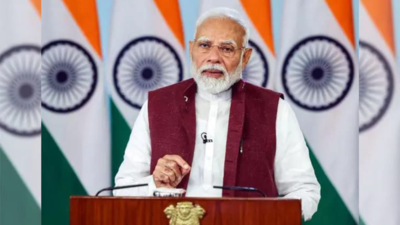NEW DELHI: Prime Minister Narendra Modi chaired the 7th meeting of the National Board for Wildlife at Gir National Park on Monday where several key conservation initiatives were announced.
The meeting reviewed India’s ongoing wildlife conservation efforts, including flagship projects like Project Tiger, Project Elephant and Project Snow Leopard. It also highlighted achievements in creating protected areas and species-specific programs.
First-ever riverine dolphin estimation report released
A significant milestone was the release of India’s first-ever riverine dolphin estimation report.
The study, which covered 28 rivers across eight states, recorded a total of 6,327 dolphins. Uttar Pradesh reported the highest population, followed by Bihar, West Bengal and Assam.
The Prime Minister stressed the importance of raising awareness and involving local communities in dolphin conservation efforts.
Expansion of Asiatic Lion conservation
The Prime Minister announced that the 16th Asiatic Lion population estimation will take place in 2025. With lions naturally dispersing to Barda Wildlife Sanctuary, conservation efforts in the region will be strengthened through prey augmentation and habitat improvements.
He also emphasised the need for eco-tourism development to support conservation efforts.
Cheetah introduction expands
Building on the ongoing Cheetah Re-introduction project, the Prime Minister declared that the initiative would be extended to Gandhisagar Sanctuary in Madhya Pradesh and Banni Grasslands in Gujarat.
New projects for Gharials and Great Indian Bustard
To address declining gharial populations, a dedicated conservation project will be launched. Additionally, the Prime Minister unveiled the National Great Indian Bustard Conservation Action Plan to upscale conservation efforts for the critically endangered bird species.
Human-wildlife conflict management
A centre of excellence for human-wildlife conflict mitigation will be established at the Wildlife Institute of India’s SACON campus in Coimbatore.
This facility will aid states and Union Territories in equipping Rapid Response Teams with advanced tracking technology, surveillance systems and conflict mitigation measures.
Technology in conservation
The Prime Minister emphasised the use of remote sensing, geospatial mapping, artificial intelligence, and machine learning to tackle forest fires and human-wildlife conflicts. He proposed collaboration between the Wildlife Institute of India and the Bhaskaracharya National Institute for Space Applications and Geo-informatics (BISAG-N) for these efforts.
He also recommended a partnership between the Forest Survey of India and BISAG-N for improved forest fire monitoring and prevention.
National referral centre for wildlife and research initiatives
Laying the foundation stone for the National Referral Centre for Wildlife at Junagadh, the Prime Minister elaborated on its role in wildlife health and disease management. He also directed the environment ministry to collect traditional knowledge and manuscripts on forest and wildlife conservation for research and development.
Strengthening conservation frameworks
The Prime Minister announced a new scheme to ensure tiger conservation outside designated reserves, aiming to reduce human-tiger conflicts while promoting coexistence with local communities. He also emphasized expanding community reserves, which have grown sixfold in the past decade, and enhancing cooperation under the United Nations Convention on Migratory Species.
Recognition of Gir’s success in conservation
Recognizing Gir National Park’s success in lion and leopard conservation, the Prime Minister suggested documenting traditional knowledge with the help of AI for broader implementation across India’s national parks and sanctuaries.
The meeting concluded with the Prime Minister flagging off motorcycles for forest staff to improve mobility and interacting with eco-guides, trackers, and frontline conservation workers at Gir.




